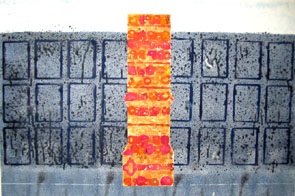Bird Island (2005)
In October 2005, an old oil pier built in the 1930s and later stripped of its platform lay abandoned off the California coast near Santa Barbara, home only to seabirds.
Considered a hazardous eyesore, it was decided to demolish what was thought to be a dangerously decrepit structure.
Bird Island, as it was dubbed, had other ideas. After repeated explosive attempts to topple the concrete caissons failed, heavy duty barges were eventually called in to pull them down.
Even the works of man, it seems, can defy man's efforts to destroy them.
In this painting I portrayed the intermediate stage of the structure between dismantling and total demolition, but in a setting amid calm waters that hints at the eventual rebirth of this industrial relic as a nature preserve.
Today, four large thin columns project from the water in a line just offshore that echoes the original structure. Each one has three triangular platforms pointing in a different direction and at a slightly different height—ideal for pelicans, cormorants and other sea birds looking for a place to rest or build a nest.
Bird Island today (photo © Callie Bowdish)

















































